Nvidia GeForce GTX 980 Graphics Card Review (2014 Archive)
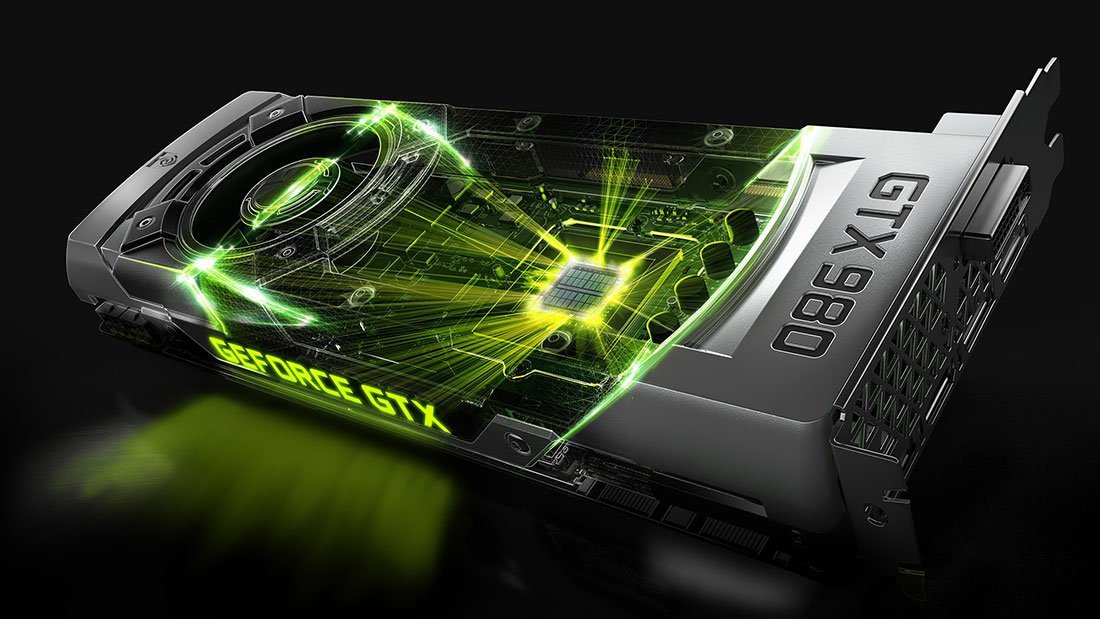
Some time ago Nvidia unveiled its new GM204 GPU. Featuring the Maxwell 2.0 architecture, the chip is installed on the GeForce GTX 980 and GTX 970 graphics cards. We’ve recently tested MSI’s original GeForce GTX 970 Gaming product and today we’re going to take a look at a reference GeForce GTX 980 and check out the new GPU’s architecture.
We’ll also benchmark the new card in comparison with its market opponents in gaming tests and at certain computing tasks.
Maxwell 2.0: On Road to Perfection
Half a year ago we examined Nvidia’s first Maxwell-based products: GeForce GTX 750 Ti and GeForce GTX 750. Although they used a junior model of the new GPU series, it sported excellent energy efficiency. Manufactured on the same 28nm technology as the earlier Kepler, it beat much more complex chips in performance while staying within a TDP of 75 watts.
And the Kepler itself had been considered the most energy-efficient architecture available! Nvidia implied then that that was just the first version of the Maxwell architecture, with the second version scheduled to appear soon in high-performance GPUs. And here they are: the GeForce GTX 980 and GeForce GTX 970 graphics cards which use the GM204 GPU with Maxwell 2.0 architecture. We don’t expect another breakthrough in terms of energy efficiency, though. The GPU is still manufactured on 28nm technology and looks like an update to Maxwell 1.0. That said, Maxwell 2.0 is still full of surprises.
SMM, PolyMorph Engine and Memory Subsystem
We had a lengthy discussion of the Maxwell 1.0 architecture in our GeForce GTX 750 Ti review, so today we focus on what differentiates Maxwell 2.0 from the first version of that architecture rather than from the Kepler design. Here’s a diagram of the GM204 processor.
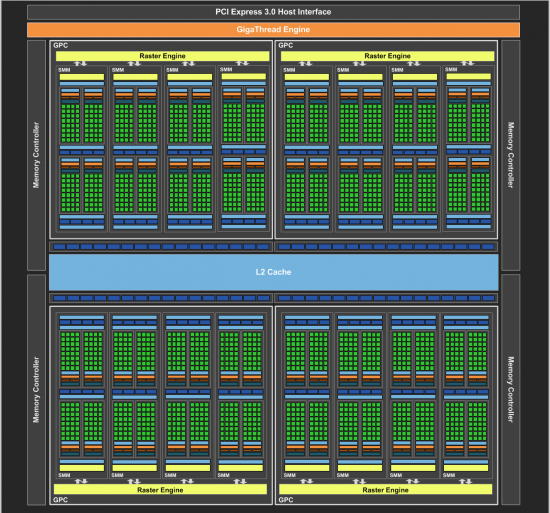
Like its predecessor GK104, the GM204 incorporates four Graphics Processing Clusters and four 64-bit memory channels. There are 16 raster operators linked to each of the memory channels, which is twice their number in the Kepler or Maxwell 1.0 design. Each GPC, in its turn, contains four updated stream multiprocessors. As opposed to the SMMs in Maxwell 1.0, they have more of shared memory (96 instead of 64 kilobytes) and a new geometry engine called PolyMorph Engine 3.0. The latter features increased performance as well as new functionality which we’ll discuss later on. The number of double-precision computing units (FP64) has been reduced to 4 per each SMM (as opposed to 6 per each SMX in the GK104). Thus, the GPU’s FP64 performance is going to be only 1/32nd of its single-precision computing speed. The GPU and the graphics card are positioned as gaming products, so this fact is hardly a problem. Moreover, the fastest GK110-based cards for floating-point computations will still be available, probably until the release of the top-end GM200 GPU targeted at professional applications. The changes we’ve just mentioned are summed up in the following table:
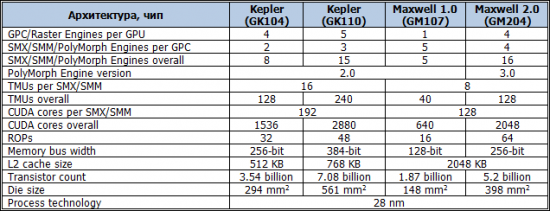
As for the memory subsystem, the GM204 has 2 megabytes of shared L2 cache memory. This is 4 times as much as in the GK104 and the same amount as in the GM107. We think all of the Maxwell-based GPUs are going to have the same amount of cache, perhaps with the exception of the top-end GM200. In our Maxwell 1.0 review we wrote that the large cache would help use graphics memory more efficiently. Maxwell 2.0 improves this even more by using new lossless data compression algorithms. They are 25% efficient on average, depending on the type of data, and help increase memory subsystem performance without raising the clock rate or making the memory bus broader. The GM204 has a 256-bit bus, yet those algorithms help ensure performance equivalent to a traditional 320-bit bus.
VXGI, DX12
Nvidia keeps on improving 3D rendering quality, trying to find new ways to achieve photorealism. That’s why the Maxwell 2.0 GPUs provide hardware acceleration for the new global illumination algorithm VXGI (Voxel Global Illumination) and support Microsoft’s upcoming DirectX 12 API. We’ll dwell on both items in more detail now.
Accurate lighting is key to making a 3D scene look photorealistic. Traditional methods have gone a long way since the T&L subunit was introduced in the GeForce 256 yet have not reached perfection. They still require some post-processing. On the other hand, the alternative scene illumination method, called Ray Tracing, has been around for a long time, too. With ray tracing, the way of lots of rays is calculated as they go from a light source, including direct and indirect lighting as well as numerous reflections. This method ensures high quality and is used for special effects in movies and cartoons, but it is too resource-consuming to be expedient in games and other real-time applications. There are no consumer-class hardware devices capable of calculating ray-tracing illumination in real time at a speed of tens of frames per second.
To address this problem, Nvidia suggested the Voxel Global Illumination algorithm in 2011. The algorithm uses a simplified version of ray tracing. First, all objects in a 3D scene are divided into rather large “bricks” called voxels and it is for such bricks that the global illumination is calculated. Instead of millions of pixels covering 3D scene objects, the illumination has to be calculated for just a few thousand voxels. And second, cones are used instead of rays, which helps save resources at a negligible reduction in quality. The VXGI tech demo showed the Apollo landing on the Moon. You can see in the screenshots how the scene was divided into voxels and how lighting was calculated for the voxel scene.
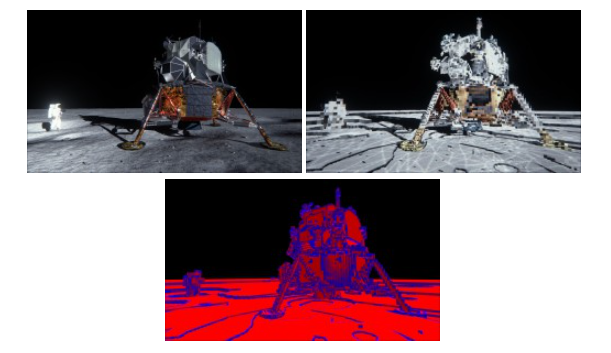
The VXGI was used in the tech demo of Unreal Engine 4. Unfortunately, for all Nvidia’s efforts, the resulting algorithm was still too resource-consuming to be executed on a single GPU. But they found a way to introduce hardware acceleration for it. That’s why the PolyMorph Engine had to be upgraded to version 3.0 in the SMMs. The VXGI is a software algorithm which can be used on any modern GPU but it runs at thrice its speed on Maxwell 2.0 GPUs thanks to the hardware acceleration.
Microsoft’s new APUs, DirectX 11.3 and DirectX 12, are supported in the Maxwell 2.0 design. DirectX 12 is an upcoming API for Microsoft’s future operating systems (presumably, Windows 9). It is going to dramatically reduce latencies when processing GPU commands and minimize CPU load. DirectX 12 won’t have new hardware requirements and will work on DirectX 11 graphics cards. As for DirectX 11, it does have some minor enhancements requiring hardware support in the latest version (DirectX 11.3). So, we don’t have any breakthroughs in this area, yet Maxwell 2.0 seems to have good potential which will be fully revealed in due time.
HDMI 2.0, DisplayPort 1.4e and NVENC
High-resolution monitors and TV-sets have become more affordable, so we can expect the mainstream format of Full-HD (1920×1080 pixels) to become outdated sooner or later. That will require not only faster graphics cards but also new video interfaces. VGA was replaced with DVI in the past, but the latter is limited to 2560×1600 at a refresh rate of 60 Hz. To get higher resolutions, we need HDMI 2.0 which is introduced in Maxwell 2.0 and supports resolutions up to 4096×2160 pixels at 60 Hz. The more perspective interface is DisplayPort, however. The GM204 GPU supports DisplayPort 1.2 and allows outputting a 5120×3200 picture at a refresh rate of 60 Hz. The earlier Kepler-based solutions were limited to 3840×2160 pixels at 60 Hz. Like the Kepler, the Maxwell 2.0 architecture supports up to four monitors simultaneously.

The video encoding/decoding engine NVENC has been improved once again. In the Maxwell 2.0 design it supports the H.265 codec which is to replace H.264. It is also 2.5 times faster with H.264 than the Kepler, allowing to encode 4K/60Hz video in real time. This functionality may be called for by the exclusive ShadowPlay feature which captures, encodes and saves video from the monitor into a file even as you’re playing a game.
New Antialiasing Methods
Nvidia introduces two new antialiasing algorithms with the GM204 and related graphics cards. The DSR algorithm (Dynamic Super Resolution) is meant for undemanding games where you can improve image quality at the expense of speed. It works by building a higher-resolution scene and compressing the resulting frame to the monitor’s resolution. For example, a frame with a resolution of 3840×2160 pixels may be built and then compressed for a Full-HD monitor (with a physical resolution of 1920×1080). This algorithm is very much alike to one of the earliest antialiasing methods but has two differences.
The classic full-screen antialiasing worked with scenes enlarged by 2 or 4 times. DSR supports a number of multipliers from 1.2 to 4.0, so it is possible to find the optimal balance between image quality and performance. The second difference is the method of compressing the enlarged frame down to the monitor’s resolution. Using a Gaussian filter with 13 samples, it reduces the amount of compression artifacts. It must be noted that the game will use a high virtual resolution and may scale its interface elements accordingly.
The minimap and other UI elements become smaller with DSR because the game engine thought it worked with a 4K monitor. The DSR algorithm is available in new drivers for all up-to-date Nvidia-based products (with the Fermi and newer designs) but Maxwell 2.0 GPUs will deliver higher performance thanks to architectural optimizations.
The other method is called Multi-Frame Antialiasing. As opposed to DSR, it is not supported by Nvidia’s earlier solutions since it requires hardware support. MFAA is meant for scenarios where the frame rate isn’t high, yet antialiasing is a requirement. This algorithm uses a subpixel sample grid for multisampling antialiasing. Unlike earlier GPUs, the GM204 allows choosing any of 256 possible subpixel patterns for each individual frame.
By sampling two different pairs of subpixels in subsequent frames and combining them with a special filter, it is possible to achieve the quality of multisampling antialiasing with four samples. In fact, the GPU will use the easier 2x MSAA method and provide the antialiasing quality of 4x MSAA. Nvidia claims that MFAA improves performance by about 30% compared to 4x MSAA.
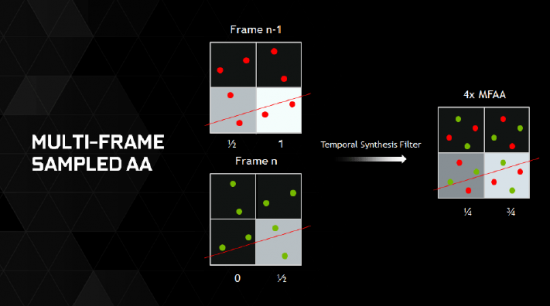
Summing everything up, we can say that the GM205 GPU and the Maxwell 2.0 design bring about quite a lot of interesting innovations even compared to Maxwell 1.0. Many of them are targeted at the future like the new API support, new algorithms for 3D scene processing, and support for high-resolution video formats. Some innovations are already applicable, so let’s check them out in our practical tests.
Specifications and Recommended Price
The Nvidia GeForce GTX 980 specifications are listed below in comparison with the reference Nvidia GeForce GTX 970, Nvidia GeForce GTX 780 Ti, Nvidia GeForce GTX 780 and AMD Radeon R9 290X.
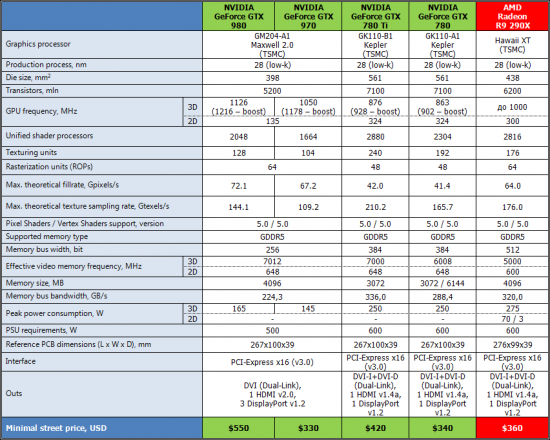
When developing the GeForce GTX 980, Nvidia followed the concept introduced in the early versions of the GeForce GTX Titan and later implemented in the GeForce GTX 780 and 780 Ti. So the new card only differs from its predecessors visually in minor details such as the model name written on its body and the black color of the heatsink you can glimpse through the window in its cooler’s casing.
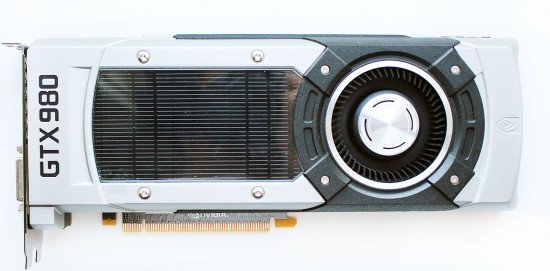
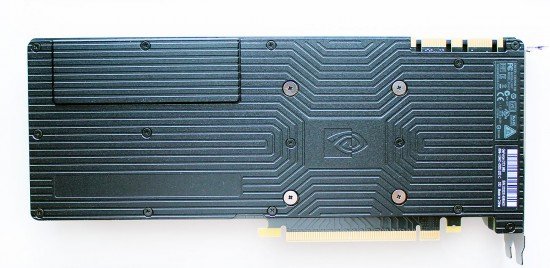
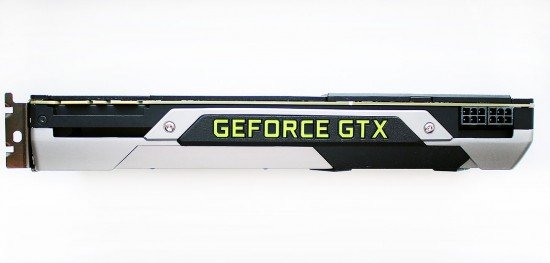
The words “GeForce GTX” on the top edge of the card are still highlighted green. The GeForce GTX 980 measures 267x100x39 millimeters which is exactly the same size as the reference GeForce GTX 780 and 780 Ti.
The mounting bracket is different. The Nvidia GeForce GTX 980 has one dual-link DVI-I connector, one HDMI 2.0 (with support for 4K/60Hz format) and as many as three DisplayPort 1.2 connectors.
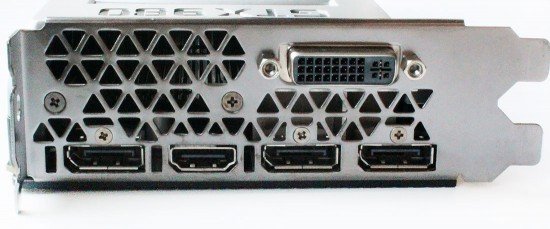
The vent grid is made up of triangle openings and has become larger.
The Nvidia GeForce GTX 980 has two connectors for building various SLI configurations.
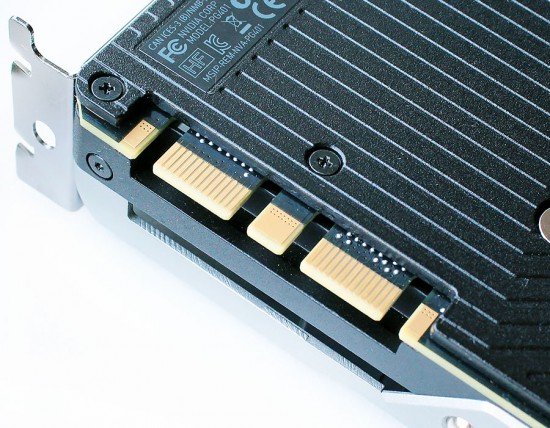
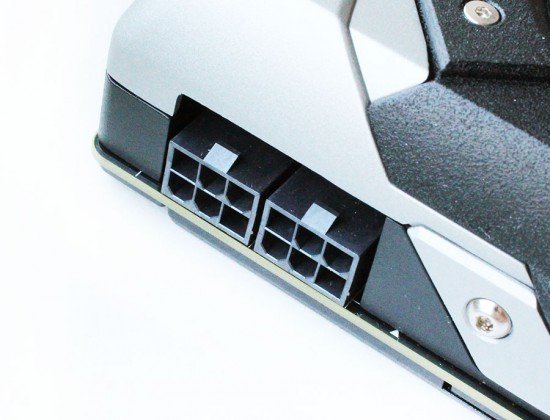
The reference version of the card has two 6-pin power connectors, which should be enough since its peak power draw is specified to be 165 watts. A 500-watt PSU is recommended for a computer with one such card inside. On the other hand, we’ve already seen original versions of the junior model, GTX 970, with 8- and 6-pin power connectors and there exist versions with two 8-pin connectors, so we guess original GTX 980s won’t come with two 6-pin power connectors, either.
There’s a small plug on the reverse side of the PCB. You should remove it when using several GTX 980 cards in SLI mode to provide more air for an adjacent card’s fan.
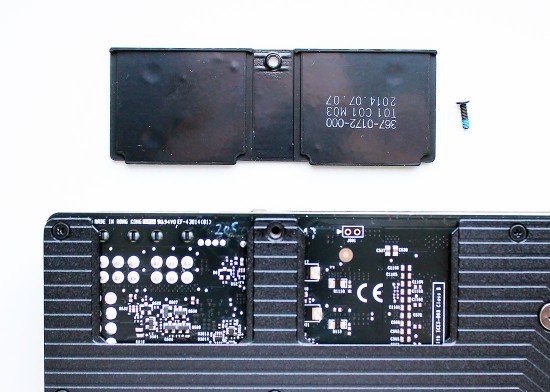
The PCB is based on the PCB of the GeForce GTX 780. It even has the same component layout because the GM204 has lower power requirements than the GK110 and the memory bus is 256 rather than 384 bits wide. All of the memory chips are located on the face side of the PCB.
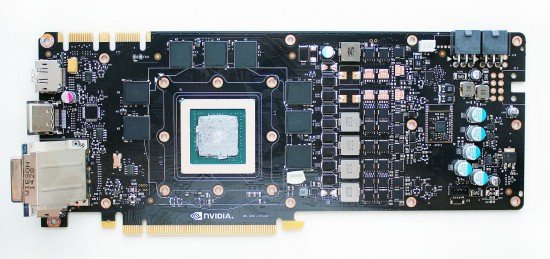
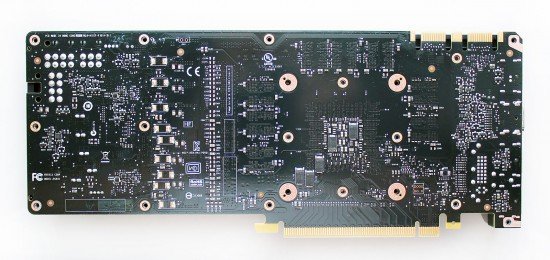
The power system features solid-state capacitors but we can note two empty places for two power phases and a place for an 8-pin power connector.
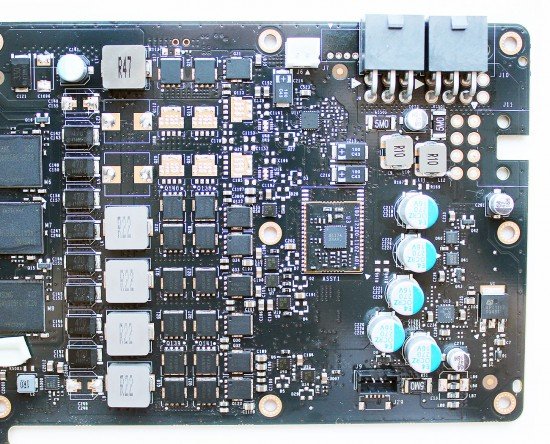
There are 4 power phases for the GPU and one more for the memory chips and PLL. There are additional solid-state capacitors opposite the GPU on the reverse side of the PCB.
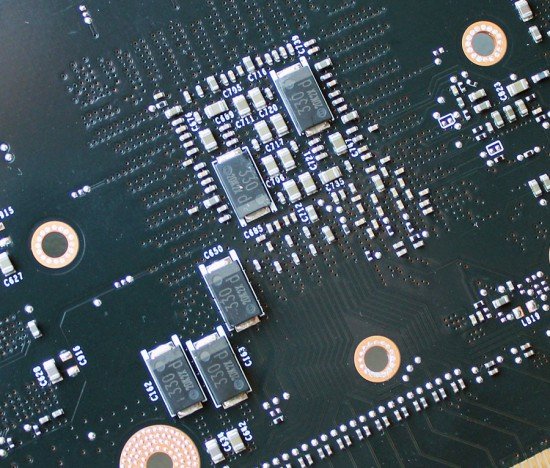
The GPU voltage regulator is based on a quad-channel controller NCP 81174 from On Semiconductor.
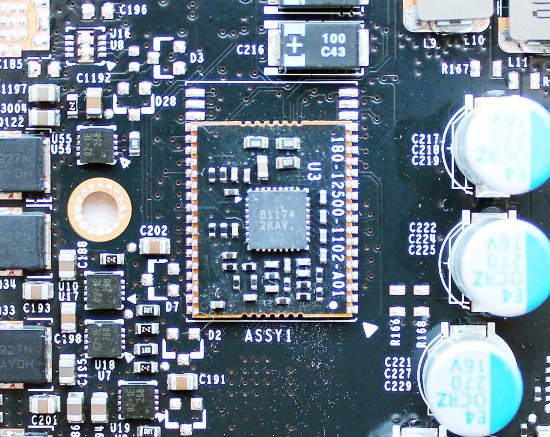
The GM204 chip is revision A1. It was manufactured in Taiwan on the 30th week of 2014 (in late July).
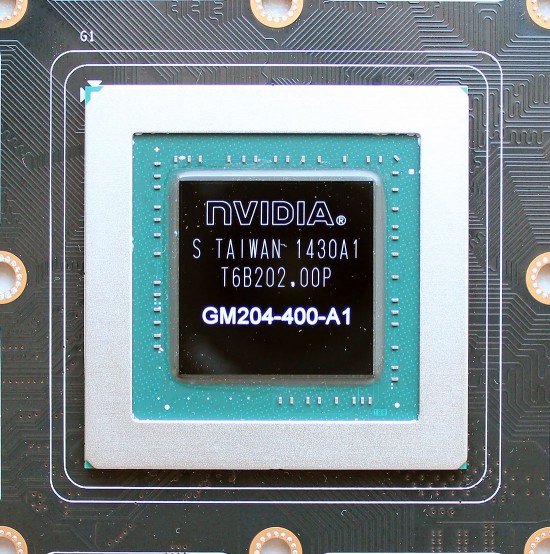
The GPU incorporates 2048 unified shader processors, 128 texture-mapping units and 64 raster operators. Its base clock rate is 1127 MHz in 3D mode and may be boosted up to 1216 MHz at high loads. In 2D mode the GPU clock rate is dropped to 100 MHz (as opposed to 324 MHz on the GeForce GTX 780 and 780 Ti, so the new card is more economical). The ASIC quality of our sample is 71.3%.
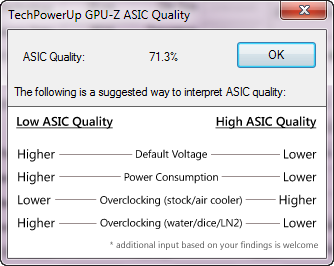
The Nvidia GeForce GTX 980 is equipped with four gigabytes of GDDR5 memory in eight chips located on the face side of the PCB. The chips were manufactured by Samsung Semiconductor and are marked as K4G41325FC-HC28.
Rated for 7012 MHz, they use a 256-bit memory bus to provide a peak bandwidth of 224.4 GB/s, exactly as on the GeForce GTX 970 but lower than on the GeForce GTX 780 Ti. The memory clock rate is dropped to 648 MHz in 2D applications.
Here’s what the GPU-Z utility has to tell us about the Nvidia GeForce GTX 980:
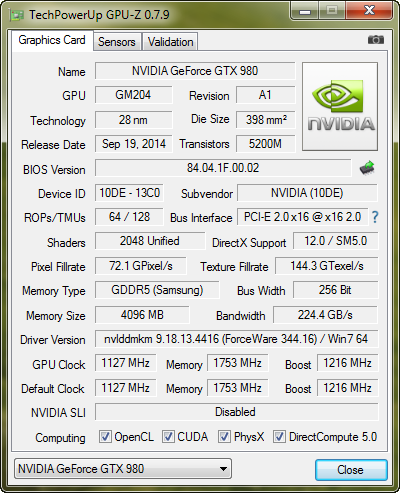
Cooling System: Noise and Efficiency
The Nvidia GeForce GTX 980 comes with the same cooler as the earlier GeForce GTX 780 and 780 Ti. It consists of a GPU heatsink, a radial fan with casing, and a massive heat-spreading plate that has contact with memory chips and power components.
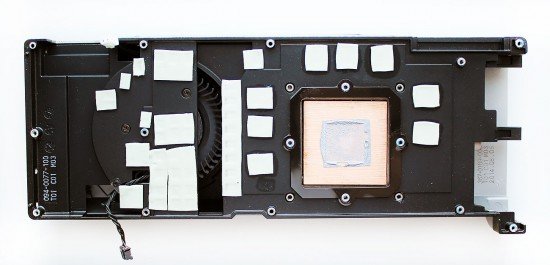
To add an aesthetic touch, the cooler is either painted or anodized black. It exhausts the hot air from the fan through the grid in the card’s mounting bracket.
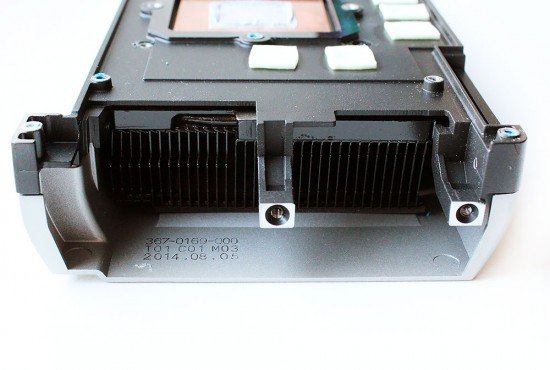
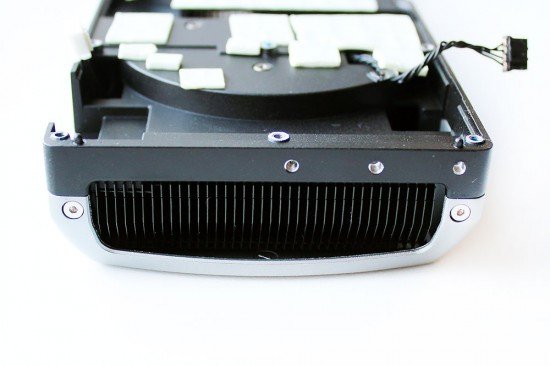
There is an ordinary copper plate instead of a vapor chamber in the heatsink base. It has three heat pipes that distribute the thermal flow within the heatsink’s base and fins.
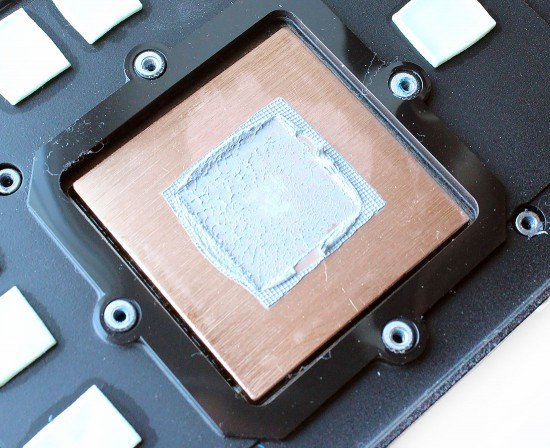
The cooler’s radial fan is PWM-regulated in a speed range of 1100 to 4200 RPM following Nvidia’s optimized algorithm. It is the same fan as we saw in Nvidia’s earlier coolers.
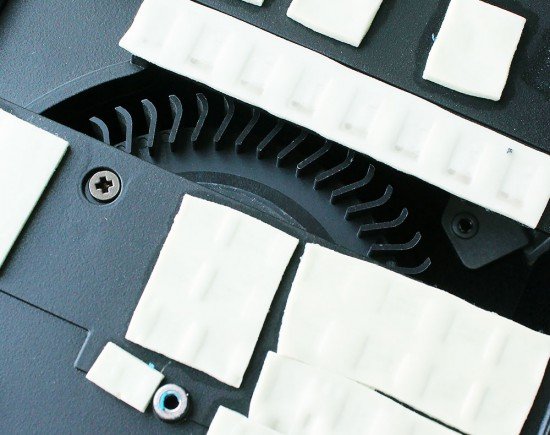
There’s thick gray-colored thermal grease between the GPU die and the heatsink’s copper base. The power components and memory chips use thermal pads.
To measure the temperature of the Nvidia GeForce GTX 980 we ran Aliens vs. Predator (2010) five times at the maximum visual quality settings, at a resolution of 2560×1440 pixels, with 16x anisotropic filtering and 4x MSAA.
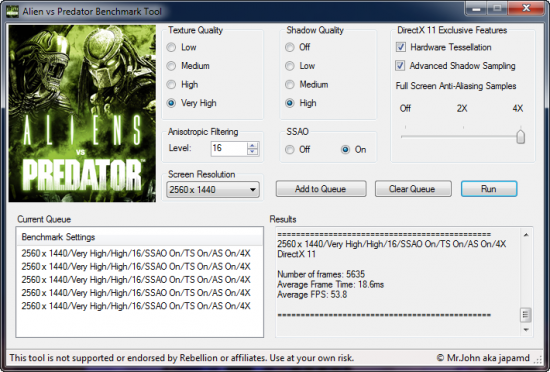
We used MSI Afterburner 4.0.0 and GPU-Z version 0.7.9 to monitor temperatures inside the closed computer case. The computer’s configuration is detailed in the following section of our review. All tests were performed at 20°C room temperature.
First we ran our Nvidia GeForce GTX 980 with its fans regulated automatically.
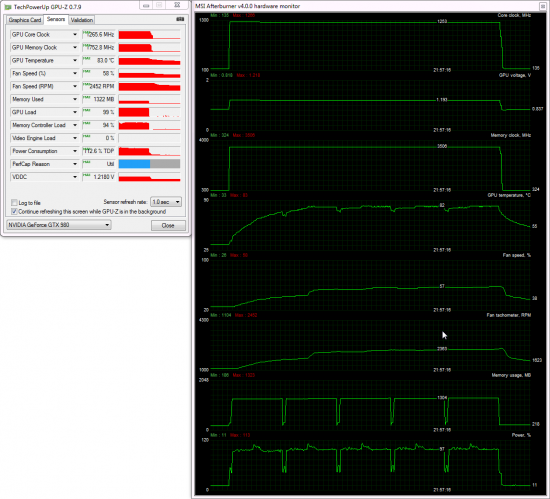
Auto fan speed mode
During the second cycle of our testing the GPU reached a temperature of 83°C and stayed at that mark thereafter. The cooler’s fan would steadily accelerate to 2450 RPM during the test, so there was no talking about acoustic comfort. Still, this is better than the reference GeForce GTX 780 Ti (the latter was tested at a 5°C higher ambient temperature, though).
At the maximum speed of the fan the Nvidia GeForce GTX 980 had a peak GPU temperature of 63°C. That’s as much as 20°C better compared to the automatic fan regulation mode.
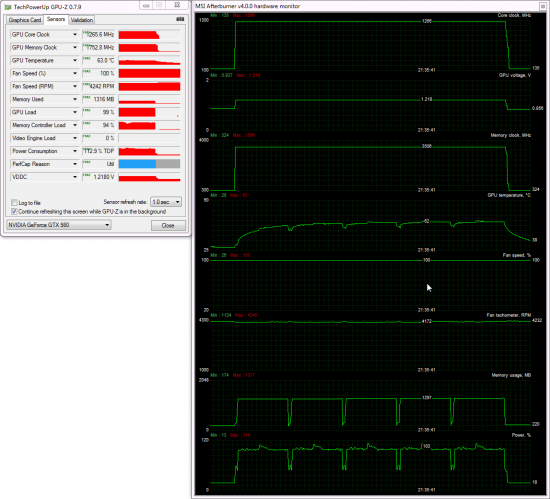
Maximum fan speed mode
Of course, the graphics card is unbearably noisy in this case, but we should note the strong correlation between such coolers’ performance and fan speed. Moreover, our monitoring tools indicate that the GPU worked at a clock rate of 1266 MHz (or 50 MHz higher than specified) most of the time. Now let’s see what peak clock rate we can reach.
Overclocking
MSI’s original GeForce GTX 970 Gaming had overclocked splendidly in our previous tests, so we expected something like that from our Nvidia GeForce GTX 980, too. Indeed, we managed to speed up its GPU by 195 MHz (+17.3%) and its memory by 880 MHz (+12.5%) without making it unstable or producing any visual artifacts.
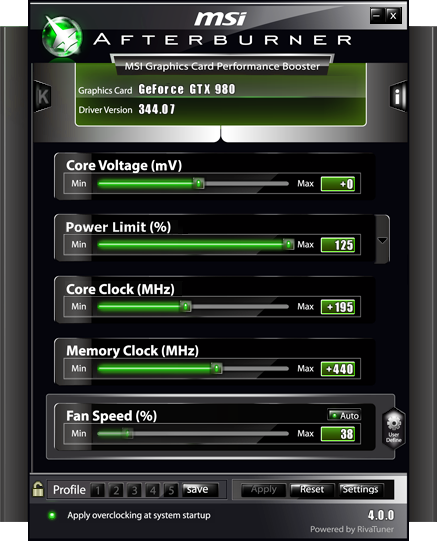
The Power Limit was set at a maximum of 125% during this experiment. The resulting clock rates were 1322-1411/7892 MHz.
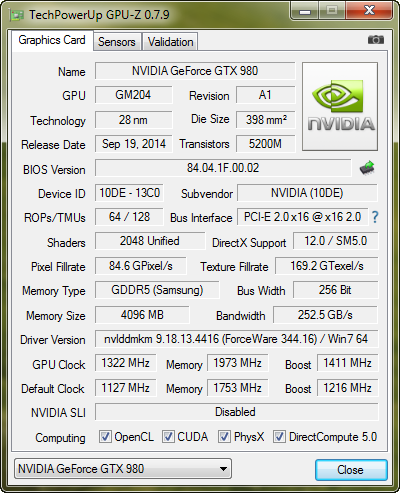
According to our monitoring tools, the GPU would work at up to 1460 MHz in 3D applications. This is lower than the 1501 MHz we had with MSI’s original GeForce GTX 970 Gaming but today we’re overclocking a reference sample with regular components and standard cooler. Original versions of the GTX 980 can be expected to reach even higher clock rates.
When overclocked, our GTX 980 had a GPU temperature up to 86°C at peak load while its fan accelerated from 2450 to 2770 RPM.
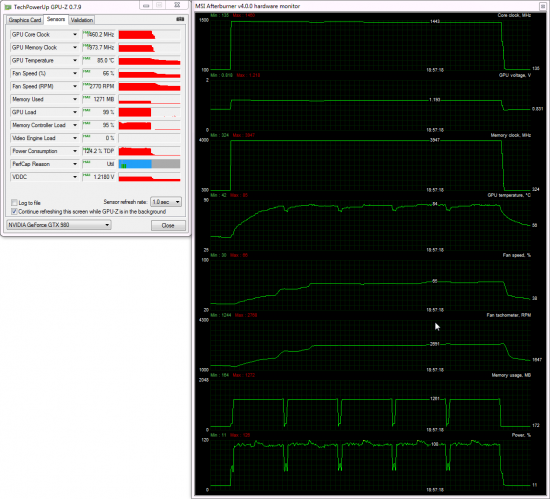
Testbed and Methods
The graphics cards are tested in a closed computer case that has the following configuration:
- Mainboard: Intel Siler DX79SR (Intel X79 Express, LGA2011, BIOS 0594 dated 06.08.2013)
- CPU: Intel Core i7-3970X Extreme Edition 3.5/4.0 GHz (Sandy Bridge-E, C2, 1.1 V, 6x256KB L2 cache, 15MB L3 cache)
- CPU cooler: Phanteks PH-TC14PЕ (with two Corsair AF140 fans working at 900 RPM)
- Thermal grease: ARCTIC MX-4
- Graphics cards: Nvidia GeForce GTX Titan (6 GB, 837-876/6008 MHz), ASUS ROG Matrix GTX 780 Ti Platinum (3 GB, 1006-1072/7000 MHz), Nvidia GeForce GTX 980 (4 GB, 1127-1216/7012 MHz and 1322-1411/7892 MHz), ASUS STRIX GTX 780 OC Edition (6 GB, 889-941/6008 MHz), AMD Radeon R9 290X (4 GB, 1000/5000 MHz)
- System memory: DDR3 4x8GB G.SKILL TridentX F3-2133C9Q-32GTX (XMP: 2133 MHz, 9-11-11-31, 1.6 volts)
- System disk: Intel SSD 730 480GB (SATA-III, BIOS vL2010400)
- Games/software disk: Western Digital VelociRaptor (SATA-2, 300 GB, 10000 RPM, 16 MB cache, NCQ) in a Scythe Quiet Drive 3.5″ enclosure
- Backup disk: Samsung EcoGreen F4 HD204UI (SATA-2, 2 TB, 5400 RPM, 32 MB cache, NCQ)
- Sound card: Auzen X-Fi HomeTheater HD
- Computer case: Antec Twelve Hundred (front panel: three Noiseblocker NB-Multiframe S-Series MF12-S2 fans at 1020 RPM; back panel: two Noiseblocker NB-BlackSilentPRO PL-1 fans at 1020 RPM; top panel: one preinstalled 200mm fan at 400 RPM)
- Control & monitoring panel: Zalman ZM-MFC3
- Power supply: Corsair AX1200i (1200 W, 120mm fan)
- Monitor: 27″ Samsung S27A850D (DVI-I, 2560×1440, 60 Hz)
As opposed to our recent MSI GeForce GTX 970 Gaming review, the Nvidia GeForce GTX 980 will have a couple of more serious opponents today: a reference Nvidia GeForce GTX Titan with 6 GB of onboard memory and an ASUS ROG Matrix GTX 780 Ti Platinum, which is one of the fastest original versions of the GTX 780 Ti model.
We’ll also throw in an ASUS Strix GTX 780 OC Edition and an AMD Radeon R9 290X.
The Strix has almost the same clock rates as the reference GTX 780 whereas the AMD card is a reference sample, so we’ll in fact compare our reference GTX 980 with reference versions of these two models.
As usual, in order to lower the dependence of the graphics cards’ performance on the overall platform speed, we overclocked our 32nm six-core CPU to 4.8 GHz by setting its frequency multiplier at x48 and enabling Load-Line Calibration. The CPU voltage was increased to 1,380 volts in the mainboard’s BIOS.
Hyper-Threading was turned on. We used 32 GB of system memory at 2.133 GHz with timings of 9-11-11-20_CR1 and voltage of 1.6125 volts.
The testbed ran Microsoft Windows 7 Ultimate x64 SP1 with all critical updates installed. We used the following drivers:
- Intel Chipset Drivers – 10.0.22 WHQL dated 05.08.2014
- DirectX End-User Runtimes, dated 30 November 2010
- Nvidia GeForce 344.11 WHQL dated 18.09.2014 and 344.16 for the GeForce GTX 980
- AMD Catalyst 14 Beta (14.300.1005.0) dated 27.08.2014
We benchmarked the graphics cards’ performance at two display resolutions: 1920×1080 and 2560×1440 pixels. There were two visual quality modes: “Quality+AF16x” means the default texturing quality in the drivers + 16x anisotropic filtering whereas “Quality+ AF16x+MSAA 4x(8x)” means 16x anisotropic filtering and 4x or 8x antialiasing. In some games we use antialiasing algorithms other than MSAA as indicated below and in the diagrams. We enabled anisotropic filtering and full-screen antialiasing from the game’s menu. If the corresponding options were missing, we changed these settings in the Control Panels of the Catalyst and GeForce drivers. We also disabled V-Sync there. There were no other changes in the driver settings.
The graphics cards were tested in two benchmarks and 14 games updated to the latest versions. Particularly, Company of Heroes 2, Total War: Rome II, Thief and GRID Autosport have got new patches. Here’s the full list of our tests (the games are sorted in the order of their release).
- 3DMark (2013) (DirectX 9/11) version 1.3.708: Cloud Gate, Fire Strike and Fire Strike Extreme scenes.
- Unigine Valley Bench (DirectX 11) version 1.0: Maximum visual quality settings, 16x AF and/or 4x MSAA, 1920×1080.
- Total War: SHOGUN 2 – Fall of the Samurai (DirectX 11) version 1.1.0: integrated benchmark (the Sekigahara battle) with maximum visual quality settings and 8x MSAA.
- Sniper Elite V2 Benchmark (DirectX 11) version 1.05: Adrenaline Sniper Elite V2 Benchmark Tool v1.0.0.2 BETA with maximum graphics quality settings (“Ultra” profile), Advanced Shadows: HIGH, Ambient Occlusion: ON, Stereo 3D: OFF, Supersampling: OFF, two sequential runs of the test.
- Sleeping Dogs (DirectX 11) version 1.5: Adrenaline Sleeping Dogs Benchmark Tool v1.0.2.1 with maximum image quality settings, Hi-Res Textures pack installed, FPS Limiter and V-Sync disabled, two consecutive runs of the built-in benchmark with quality antialiasing at Normal and Extreme levels.
- Hitman: Absolution (DirectX 11) version 1.0.447.0: built-in test with Ultra settings, enabled tessellation, FXAA and global lighting.
- Crysis 3 (DirectX 11) version 1.2.0.1000: maximum visual quality settings, Motion Blur – Medium, lens flares – on, FXAA and MSAA 4x, two consecutive runs of a scripted scene from the beginning of the “Swamp” mission (110 seconds long).
- Tomb Raider (2013) (DirectX 11) version 1.1.748.0: we used Adrenaline Benchmark Tool, all image quality settings set to “Ultra”, V-Sync disabled, FXAA and 2x SSAA antialiasing enabled, TessFX technology activated, two consecutive runs of the in-game benchmark.
- BioShock Infinite (DirectX 11) version 1.1.25.5165: we used Adrenaline Action Benchmark Tool with “Ultra” and “Ultra+DOF” quality settings, two consecutive runs of the in-game benchmark.
- Metro: Last Light (DirectX 11) version 1.0.0.15: we used the built-in benchmark for two consecutive runs of the D6 scene. All image quality and tessellation settings were at “Very High”, Advanced PhysX technology enabled, with and without SSAA antialiasing.
- Company of Heroes 2 (DirectX 11) version 3.0.0.15370: two consecutive runs of the integrated benchmark at maximum image quality and physics effects settings.
- Total War: Rome II (DirectX 11) version 2.0.0.0: Extreme quality, V-Sync disabled, SSAA enabled, two consecutive runs of the integrated benchmark.
- Batman: Arkham Origins (DirectX 11) version 1.0 update 8: Ultra visual quality, V-Sync disabled, all the effects enabled, all DX11 Enhanced features enabled, Hardware Accelerated PhysX = Normal, two consecutive runs of the in-game benchmark.
- Battlefield 4 (DirectX 11) – version 111433: Ultra settings, two successive runs of a scripted scene from the beginning of the “Tashgar” mission (110 seconds long), with the Mantle API enabled for AMD-based cards.
- Thief (DirectX 11) version 1.6 build 4158.14: Maximum visual quality settings, Parallax Occlusion Mapping and Tessellation enabled, a double run of the in-game benchmark with the Mantle API enabled for AMD-based cards.
- GRID Autosport (DirectX 11) version 1.101.7026: the visual quality settings were all at their maximums, the tests were run with and without 8x MSAA with ten cars on the San Francisco track.
We publish the bottom frame rate for games that report it. Each test was run twice, the final result being the best of the two if they differed by less than 1%. If we had a larger difference, we reran the test at least once again to get repeatable results.
Performance Tests
The Nvidia-based solutions of the previous generations (ASUS STRIX GTX 780 OC Edition and ASUS ROG Matrix GTX 780 Ti Platinum) are colored light green in the diagrams below. The color of the Radeon R9 290X is AMD’s traditional red. The Nvidia GeForce GTX 980 is teal whereas the Nvidia GeForce GTX Titan is dark-blue. The results are sorted in the order of descending price.
We’ll start out with semisynthetic benchmarks.
3DMark (2013)
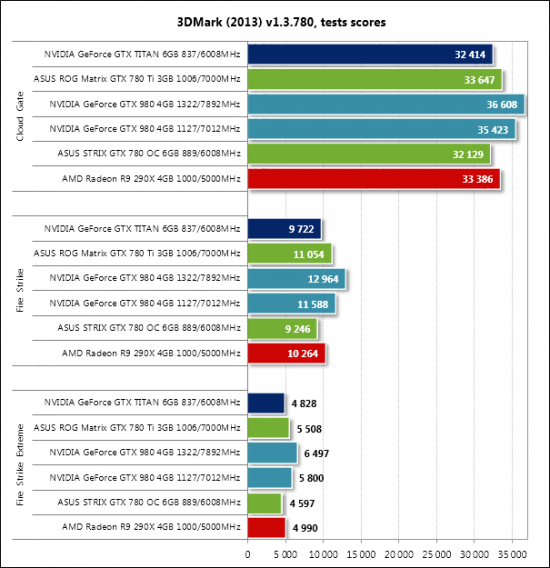
The new Nvidia GeForce GTX 980 delivers excellent performance in our first test. It is much faster than its opponents, both Nvidia- and AMD-based. The original ASUS ROG Matrix GTX 780 Ti Platinum is the closest to the leader, yet the gap between them is as large as 5.3% in the hardest test mode. And if the GeForce GTX 980 is overclocked, its performance improves by up to 12%, which is just perfect for a reference sample.
Unigine Valley Bench
This semisynthetic benchmark shows us a somewhat different picture:
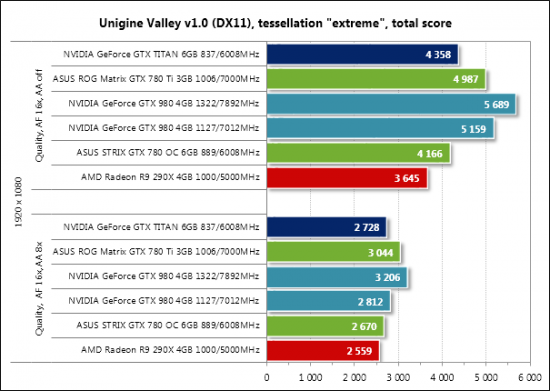
It is the AMD Radeon R9 290X rather than the ASUS Strix GTX 780 OC Edition which is the slowest card here. The GeForce GTX Titan is third whereas the Nvidia GeForce GTX 980 is competing with the ASUS ROG Matrix GTX 780 Ti Platinum, going ahead without antialiasing and falling behind with 8x MSAA turned on. Obviously, this is due to the difference between the GTX 780 Ti’s 384-bit bus and the GeForce GTX 890’s 256-bit one because high memory bandwidth is important for high resolutions with antialiasing.
Total War: Shogun 2 – Fall of the Samurai
The first game on our list is quite old, yet it is by far not the easiest test.
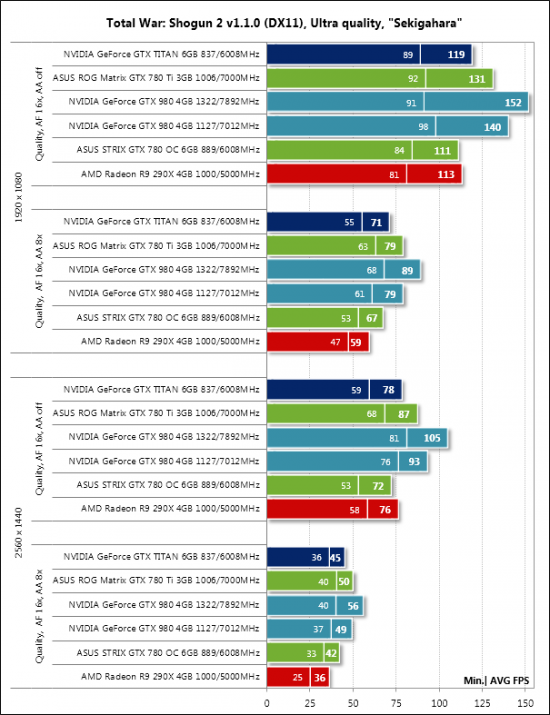
We’ve got interesting results which resemble those of Unigine Valley. With MSAA turned off, the GeForce GTX 980 is unrivalled, so the new GPU is a good thing indeed. When we enable antialiasing, the ASUS ROG Matrix GTX 780 Ti Platinum challenges the leader thanks to its higher memory bandwidth. You may imagine how much faster the GTX 980 Ti could be with a 384-bit bus! Well, Nvidia is in no hurry yet to launch such a card because the current version of the GTX 980 Ti is sufficient for now. As for the other products, the Nvidia GeForce GTX 980 is up to 29% faster than the ASUS Strix GTX 780 OC Edition whereas the AMD Radeon R9 290X slows down when we enable 8x MSAA.
Sniper Elite V2 Benchmark
This test produces the same picture as the previous one:
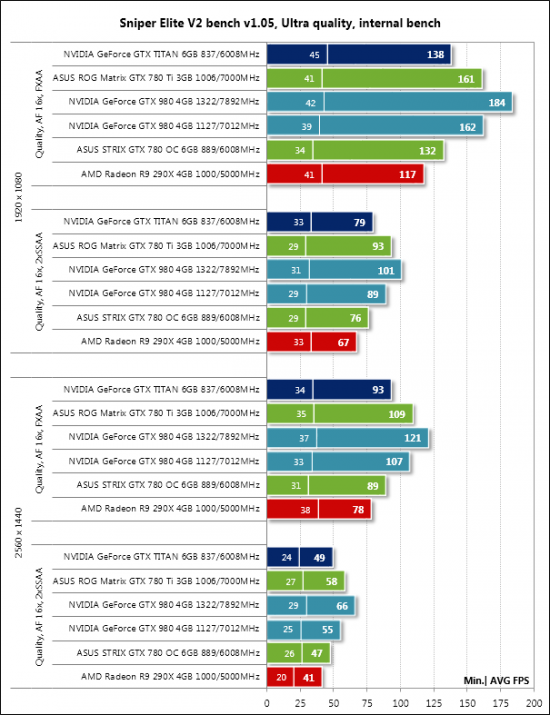
The Nvidia GeForce GTX 980 is 33 to 39% faster than the AMD Radeon R9 290X and 17 to 23% ahead of the ASUS Strix GTX 780 OC Edition. It is roughly equal to the ASUS ROG Matrix GTX 780 Ti Platinum, losing by 3 fps in the hardest test mode only. Our overclocking provides a 20% performance boost, making the GTX 980 an indisputable winner of this test. Of course, we should keep it in mind that the other graphics cards may be overclocked to some extent, too.
Sleeping Dogs
This game is over 2 years old, so we can hardly expect it to be a serious load for modern graphics hardware. However, if we enable antialiasing and a resolution of 2560×1440 pixels, Sleeping Dogs is still capable of fully loading a top-end graphics card.
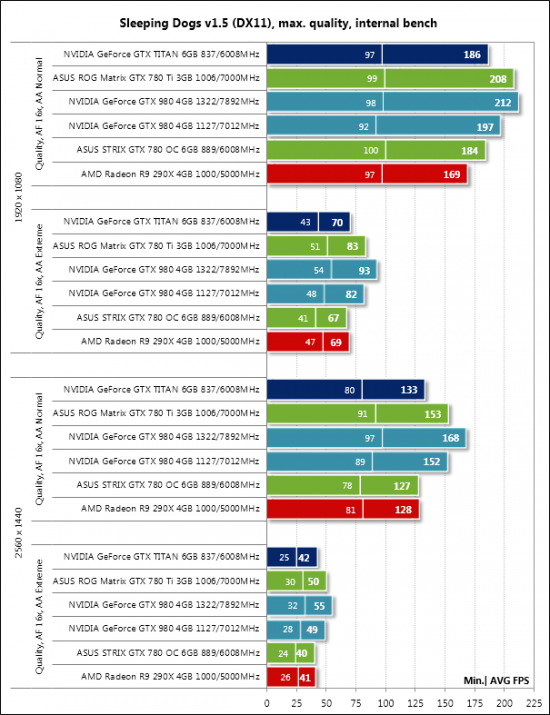
The reference Nvidia GeForce GTX 980 is never slower than the ASUS ROG Matrix GTX 780 Ti Platinum, which is one of the fastest original versions of the GTX 780 Ti. The ASUS Strix GTX 780 OC Edition and the AMD Radeon R9 290X are slower by 20% and more. Although the Nvidia GeForce GTX Titan was released a year and a half ago, its performance is still convincing as it finds itself in between the two leaders and the two losers (ASUS STRIX GTX 780 OC Edition and AMD Radeon R9 290X). Well, the Titan is still a niche product that comes at a very high price.
Hitman: Absolution
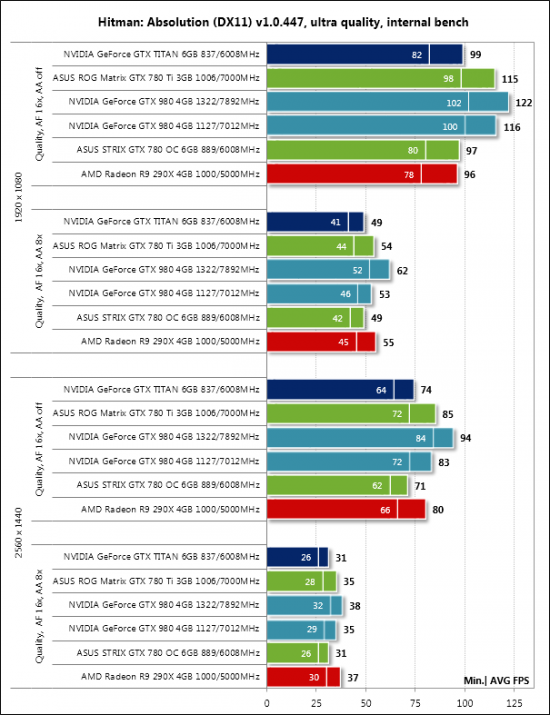
Hitman: Absolution is the only game in this test session where the AMD Radeon R9 290X, which is likely to remain AMD’s single-processor flagship for the next few months or even half-year, is competitive against the Nvidia GeForce GTX 980 and even slightly faster in the hardest test mode. Otherwise, we see the same picture as in the previous tests: the Nvidia GeForce GTX 980 is 8 to 20% ahead of the ASUS Strix GTX 780 OC Edition and equal to the original ASUS ROG Matrix GTX 780 Ti Platinum. Overclocking adds up to 17% to the new card’s performance.
Crysis 3
We’ve got somewhat different results in this game.
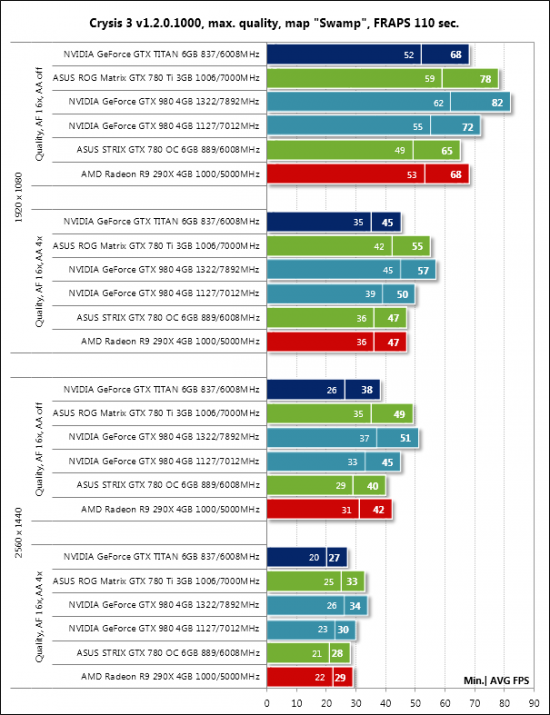
The Nvidia GeForce GTX 980 enjoys a smaller advantage over the ASUS Strix GTX 780 OC Edition and the AMD Radeon R9 290X than in the previous tests. It varies between 3% and 13%. Moreover, the ASUS ROG Matrix GTX 780 Ti Platinum is always faster than the Nvidia GeForce GTX 980. The latter is only competitive when overclocked. Then, the AMD Radeon R9 290X, despite its default clock rates and reference cooler (with the ensuing frequency drops due to overheat), successfully competes with the original ASUS Strix GTX 780 OC Edition and even leaves it behind in three out of the four test modes.
Tomb Raider (2013)
This game produces typical standings.
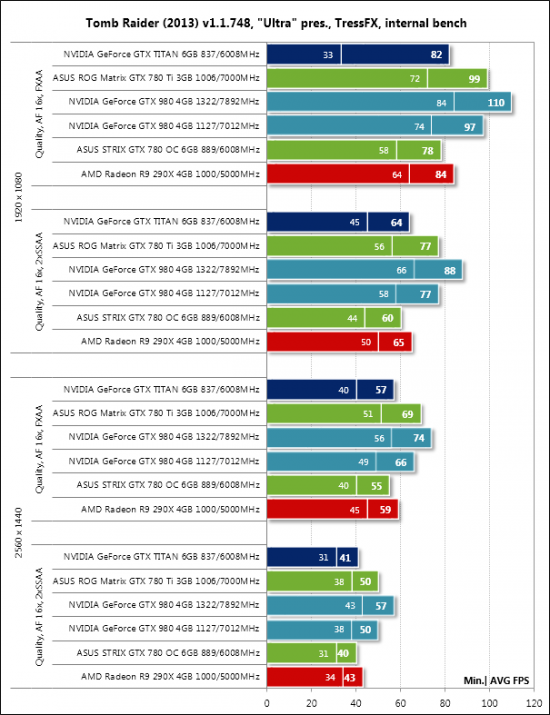
The Nvidia GeForce GTX 980 is 20-28% ahead of the ASUS Strix GTX 780 OC Edition and 16-18% ahead of the AMD Radeon R9 290X. It is overall as fast as the ASUS ROG Matrix GTX 780 Ti Platinum, too. Our overclocking makes the GTX 980 faster by up to 14%.
BioShock Infinite
The integrated benchmark from BioShock Infinite has a very low bottom speed on Nvidia-based graphics cards. The game isn’t new, so the developers must have been unable to correct the issue with patches or driver updates.
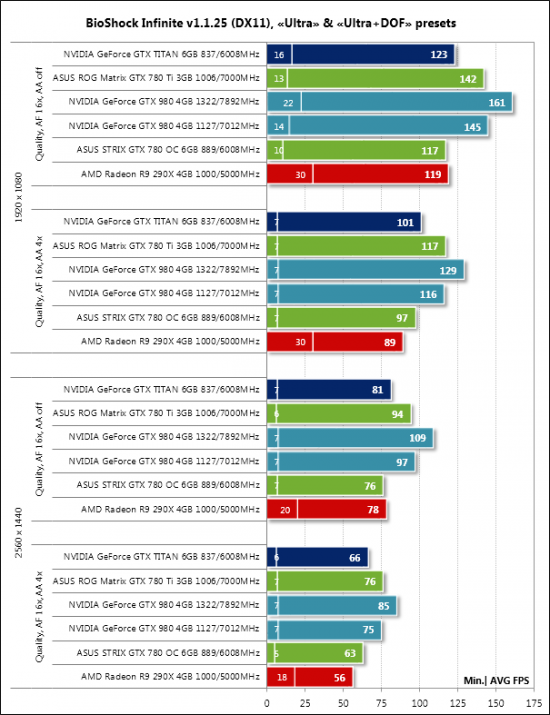
Otherwise, we have the same picture as in the previous tests. The ASUS Strix GTX 780 OC Edition and the AMD Radeon R9 290X go neck and neck, although the AMD is somewhat slower when we enable antialiasing. The $1000 GeForce GTX Titan is second whereas the top place is shared by the reference GeForce GTX 980 and the original ASUS ROG Matrix GTX 780 Ti Platinum. Overclocking adds 11-13% to the performance of the GTX 980, making it the winner of this test.
Metro: Last Light
When the Advanced PhysX option is enabled, the AMD Radeon R9 290X is absolutely uncompetitive even though we’ve got a rather fast CPU in our testbed.
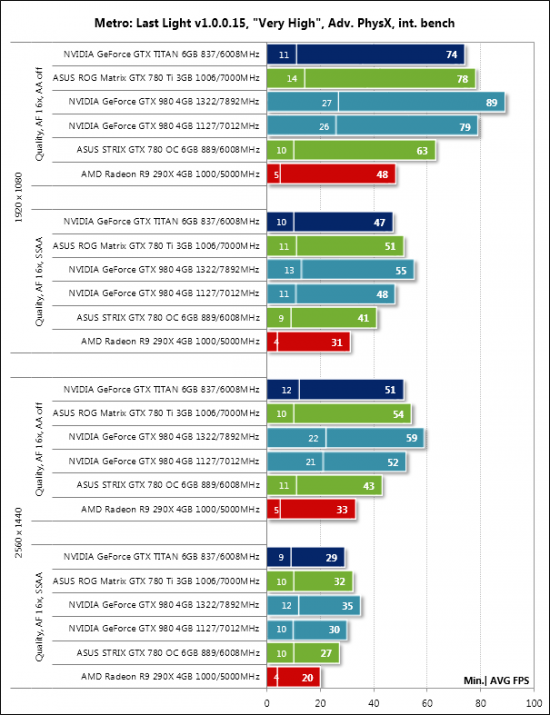
But with Advanced PhysX turned off, the reference Radeon R9 290X delivers the same performance as the original ASUS Strix GTX 780 OC Edition.
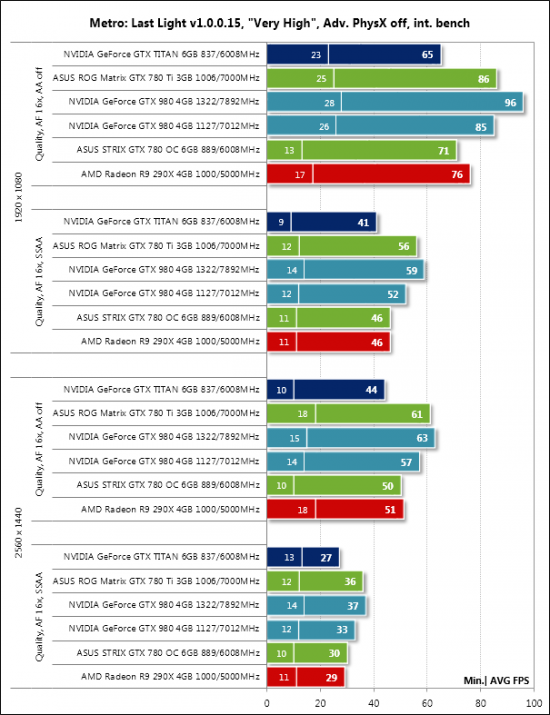
As for the Nvidia GeForce GTX 980, it is not much slower than the factory-overclocked ASUS ROG Matrix GTX 780 Ti Platinum. We can get the same or even more performance by overclocking our GeForce GTX 980.
Company of Heroes 2
The game’s engine is better optimized for AMD GPUs, so it is no wonder that the Radeon R9 290X performs successfully here.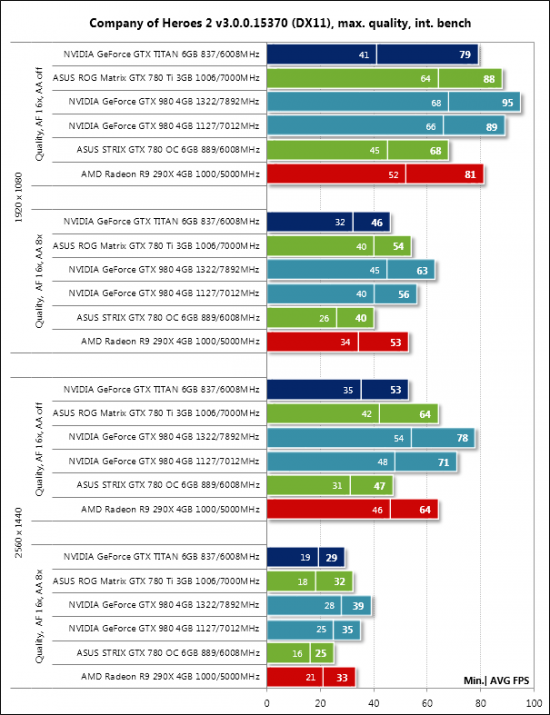
Unlike in most other tests, the Nvidia GeForce GTX 980 beats the original ASUS ROG Matrix GTX 780 Ti Platinum at any visual quality settings. When overclocked, it gets 7 to 13% faster.
Total War: Rome II
Here’s another game where the Nvidia GeForce GTX 980 is consistently faster than the ASUS ROG Matrix GTX 780 Ti Platinum.
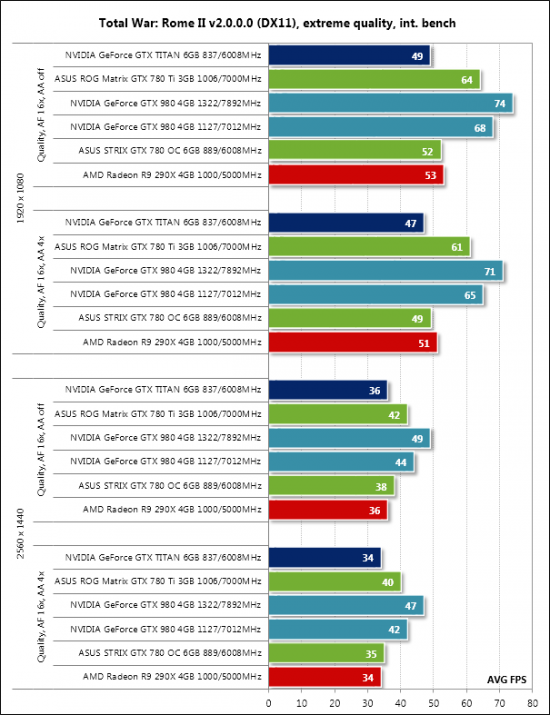
We get the same performance from three cards: ASUS Strix GTX 780 OC Edition, AMD Radeon R9 290X and Nvidia GeForce GTX Titan. All of them are 16 to 39% slower in comparison with the reference Nvidia GeForce GTX 980.
Batman: Arkham Origins
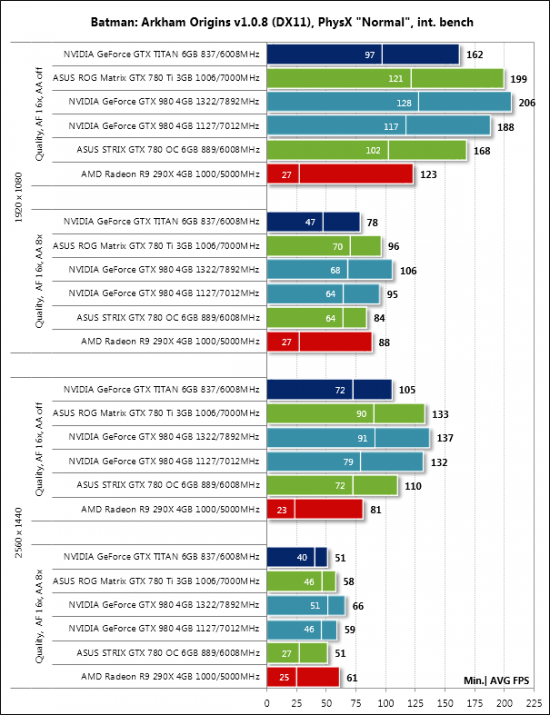
There are only two things we can note about the Batman: Arkham Origins results. First, our overclocking adds only 3 to 11% to the performance of the Nvidia GeForce GTX 980. And second, the AMD Radeon R9 290X is as good as Nvidia’s new flagship at the hardest settings.
Battlefield 4
This game produces a typical picture for our today’s test session.
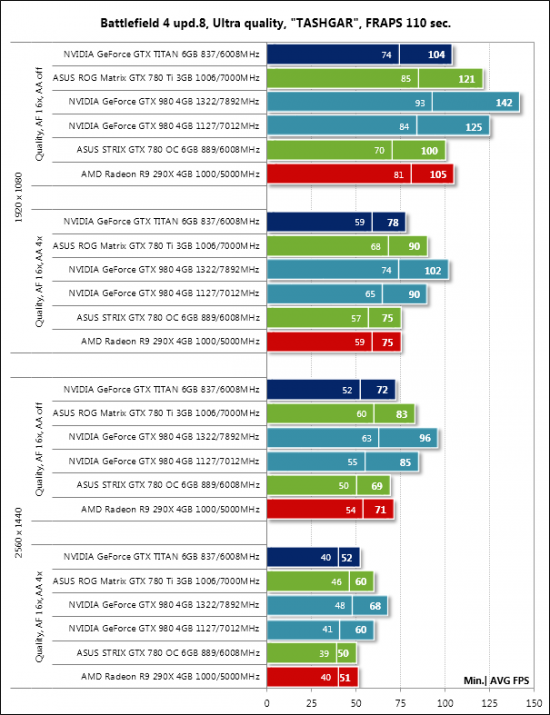
The Nvidia GeForce GTX 980 is up to 24% ahead of the ASUS Strix GTX 780 OC Edition and AMD Radeon R9 290X. It is also equal to the original ASUS ROG Matrix GTX 780 Ti Platinum in performance. Our overclocking accelerates the new card by 13-14%.
Thief
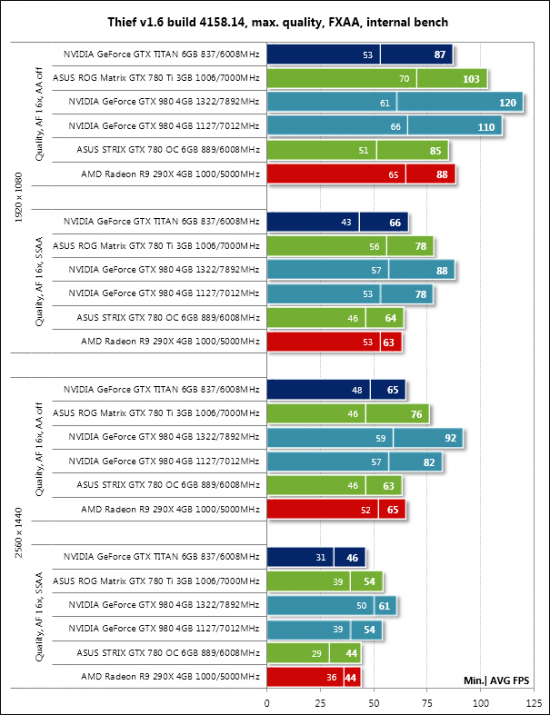
We’ve got the same picture overall as in the previous test.
GRID Autosport
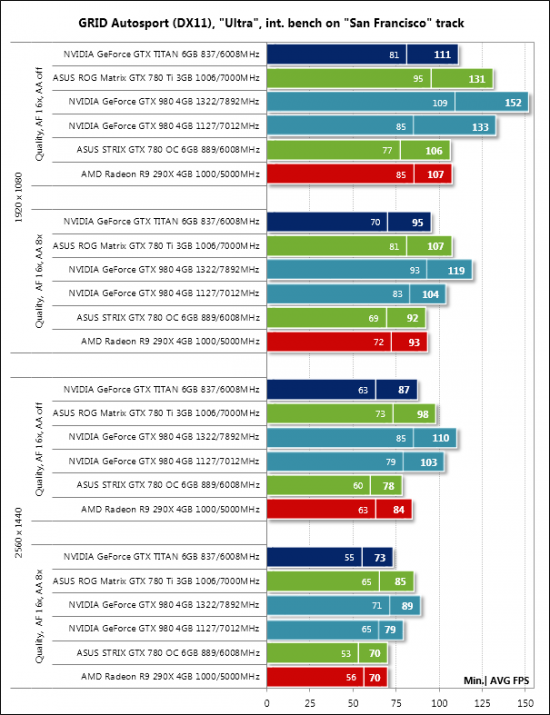
This game doesn’t show us anything extraordinary compared to the other tests.
Our test results are summed up in the following table when the average and minimum speed are indicated for each graphics card.
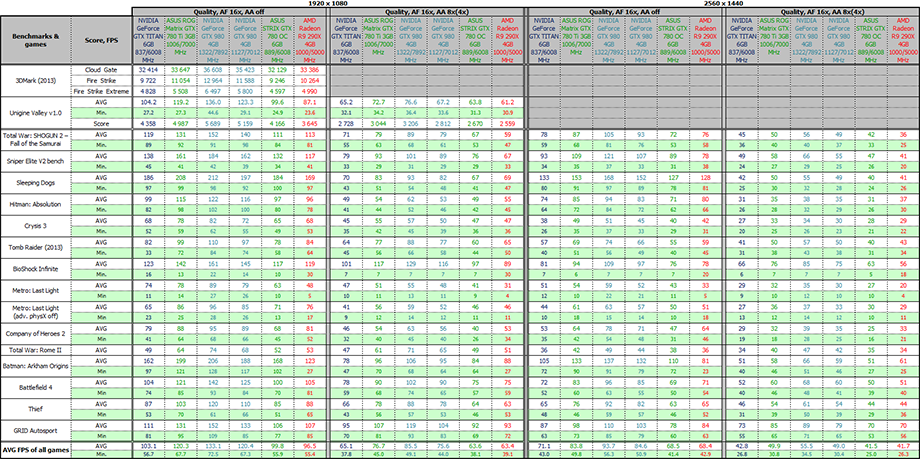
Now we can proceed to our performance summary charts.
Performance Summary Charts
Since we’ve got reasons to believe that the GeForce GTX 980 will be followed by an even faster GeForce GTX 980 Ti, the new card should be compared to the GeForce GTX 780. That’s why our first pair of summary charts is about the Nvidia GeForce GTX 980 vs. the ASUS Strix GTX 780 OC Edition, the latter serving as the baseline.
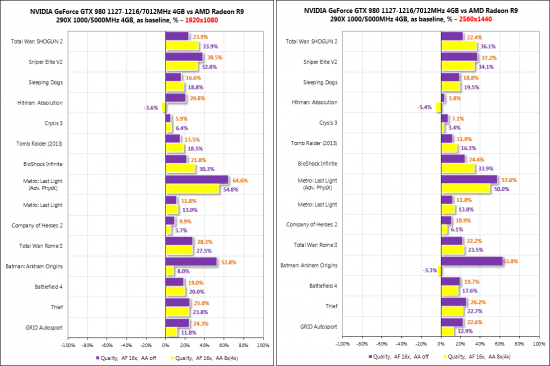
The new card is superior in every test, even CPU-dependent ones. The gap is the smallest in Crysis 3 and the largest in Company of Heroes 2. The average advantage of the Nvidia GeForce GTX 980 over the ASUS Strix GTX 780 OC Edition is 19-22% at 1920×1080 and 18-24% at 2560×1440.
Next, let’s compare the Nvidia GeForce GTX 980 with the AMD Radeon R9 290X.
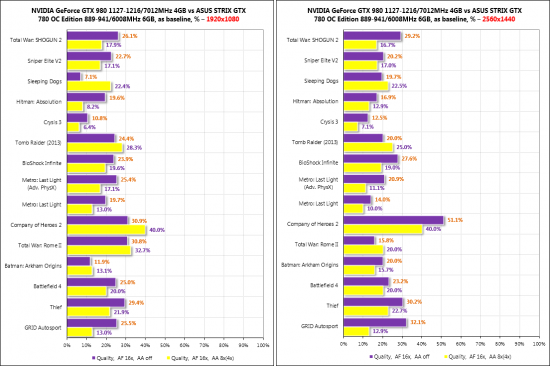
The Nvidia card enjoys a smaller advantage here, yet loses only one test mode (in Hitman: Absolution). The largest gap between the two cards can be observed in Metro: Last Light (with Advanced PhysX enabled), Batman: Arkham Origins (without antialiasing) and Sniper Elite V2. The average advantage of the GeForce GTX 980 across all of our tests is 20-25% at 1920×1080 and 18-24% at 2560×1440.
The next opponent for the Nvidia GeForce GTX 980 is the most serious one. It is a factory-overclocked Ti version of the GeForce GTX 780 from ASUS. And the GTX 980 turns out to be as fast as the ASUS ROG Matrix GTX 780 Ti Platinum:
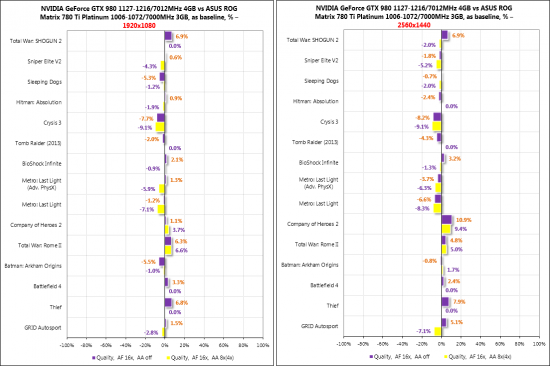
It looks like there’s no reason to upgrade from a GeForce GTX 780 Ti, especially a factory-overclocked one, to a GeForce GTX 980 as you get no performance benefits. The new card is quite attractive anyway as its recommended price is lower than that of the GeForce GTX 780 Ti at the time of the latter’s release.
And the last pair of summary charts shows us the performance boost the Nvidia GeForce GTX 980 gets from our overclocking. To remind you, we overclocked its GPU and memory by 17.3% and 12.5%, respectively.
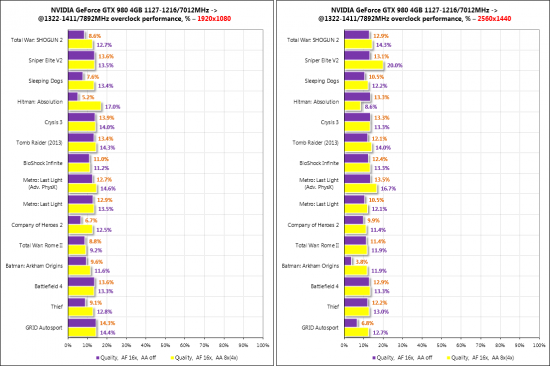
The new card sports very good performance scalability. The average performance growth is 11 to 13% across all of our tests at both resolutions. We also hope that original GeForce GTX 980 models will have even higher overclocking potential.
CompuBench CL Tests and Password Breaking with Elcomsoft Wireless Security Auditor
We will check out the computing performance of our graphics cards with CompuBench CL. It benchmarks GPU performance at various loads: facial recognition, physical process simulation and cryptocurrency mining.
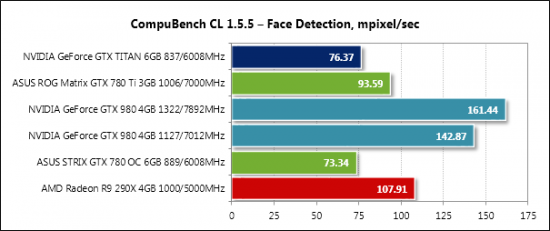
The Nvidia GeForce GTX 980 is twice as fast as the ASUS Strix GTX 780 OC and 53% faster than the ASUS ROG Matrix GTX 780 Ti Platinum when recognizing faces using the Viola-Jones algorithm. It also beats the previous winner AMD Radeon R9 290X.
The optical flow calculated in the following test is widely used in video compression for improving image quality.
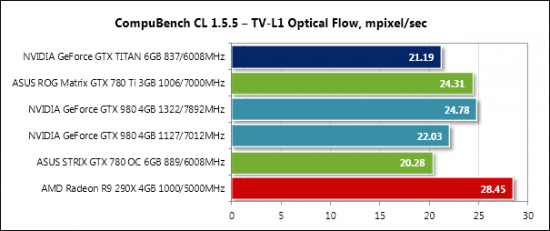
The Nvidia GeForce GTX 980 isn’t much faster compared to the older cards in this test. It can only catch up with the ASUS ROG Matrix GTX 780 Ti Platinum when overclocked. And the AMD Radeon R9 290X remains unrivalled.
The Ocean Surface Simulation test is based on Fourier transformations which are widely used in engineering, mathematics and other sciences. Here are the results:
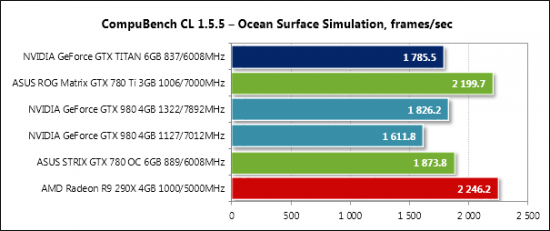
The GeForce GTX 980 is far from brilliant here. It even falls behind the ASUS Strix GTX 780 OC. The test is won by the ASUS ROG Matrix GTX 780 Ti Platinum and AMD Radeon R9 290X.
The new card from Nvidia is superior in the OpenCL-based particle simulation test, though:
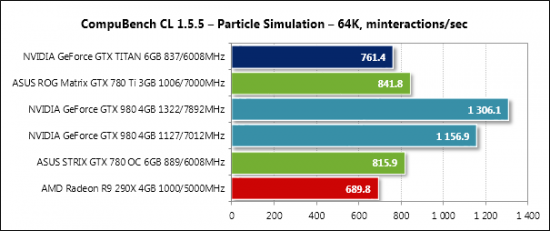
Its performance is much higher compared to the cards of the previous generation.
The GeForce GTX 980 scores another win in the Video Composition test:
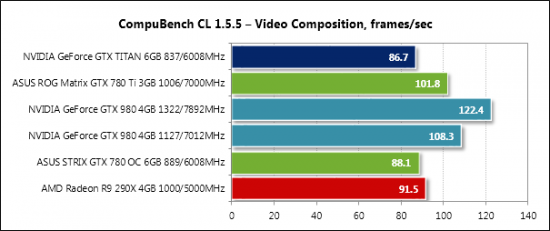
And here are its results in the Bitcoin mining test:
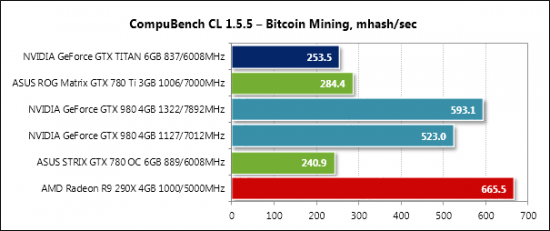
It is no wonder that the AMD Radeon R9 290X wins the test but the GeForce GTX 980 is much closer to the leader than Nvidia’s earlier solutions. The increased performance may come in handy if mining becomes profitable again.
The last test of the GM204’s computing power is about password breaking with Elcomsoft Wireless Security Auditor. The result is the average number of passwords per second processed in 1 minute after the start of the attack.
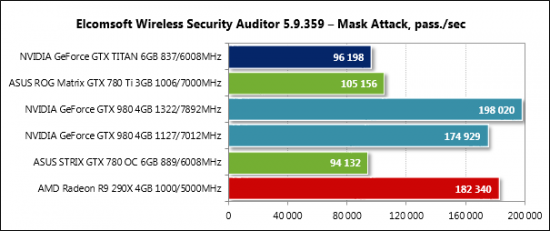
And again the new GPU is much faster than its predecessors although the AMD Radeon R9 290X is still ahead of the GeForce GTX 980.
Power Consumption
We measured the power consumption of computer systems with different graphics cards using a multifunctional panel Zalman ZM-MFC3 which can report how much power a computer (the monitor not included) draws from a wall socket. There were two test modes: 2D (editing documents in Microsoft Word and web surfing) and 3D (the intro scene of the Swamp level from Crysis 3 running four times in a loop at 2560×1440 with maximum visual quality settings but without MSAA). Here are the results:
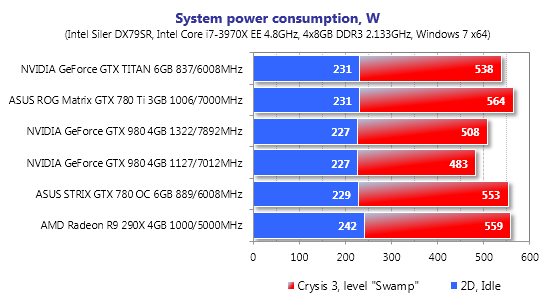
The configuration with the fastest graphics card of this test session, Nvidia GeForce GTX 980, turns out to be the most economical one, too. It needs 483 watts at peak load, which is 20 watts less than required by the configuration with ASUS Strix GTX 780 OC and 76 to 81 watts less compared to the configurations with ASUS ROG Matrix GTX 780 Ti Platinum and AMD Radeon R9 290X. Even when the GeForce GTX 980 is overclocked, the computer barely exceeds the capabilities of a 500-watt PSU and needs a mere 5 watts more than the peak power draw of the ASUS Strix GTX 780 OC configuration. The graphics cards all consume about the same amount of power in 2D mode, except that the AMD Radeon R9 290X needs somewhat more than the others.
Conclusion
Summing up our today’s tests, we must admit that the Nvidia GeForce GTX 980 is a noteworthy innovation which serves as a good replacement not only for the GeForce GTX 780 but also for the faster GTX 780 Ti. At its default clock rates, the new card is faster than the GTX 780 and equal to the GTX 780 Ti in terms of performance, but has a lower operating temperature, produces less noise and consumes less power. And all of this is offered at a lower recommended price ($549) than at the release of the GeForce GTX 780 ($649) and especially GeForce GTX 780 Ti ($699). Coupled with its excellent overclocking potential, increased computing performance, support for new technologies and antialiasing methods, and HDMI 2.0, we’ve got a graphics card we could only dream of!
Still, from the standpoint of performance only, there’s no reason to upgrade from an original GeForce GTX 780 Ti to a GeForce GTX 980 as we’ve seen in our tests with the ASUS ROG Matrix GTX Ti Platinum. Judging by the GM204 GPU and the reference PCB that seems to have enough room for more components, we are sure we’ll soon see even faster cards like a GeForce GTX 980 Ti or a GTX Titan II. But if you are buying a new card, the choice between a GeForce GTX 980 and a GTX 780 Ti is obvious. The former is absolutely superior in the sum of its characteristics.
As for AMD, we’re now waiting for an adequate answer from Nvidia’s opponent.